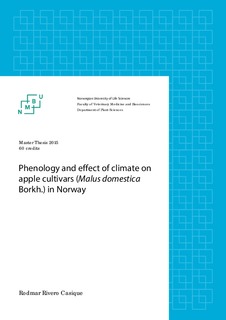| dc.description.abstract | Successful fruit growing is dependent on a good control of flower-bud formation (FBF), knowledge on the timing of developmental processes in the tree, and how these are related to each other in the Norwegian climate and in different cultivars. In the current study, FBF was investigated in relation to climate and developmental processes such as growth cessation, anthesis, fruit ripening and leaf abscission in 14 early, middle and late flowering apple cultivars at Ås in Norway. In addition, the effect of the local climate at Landvik, Ås, Ullensvang, Kapp and Stjørdal on FBF and development of young trees of ‘Aroma’ and ‘Gravenstein’ was studied. The onset of FBF differed between shoot types and cultivars. It started first in spurs of actively growing trees, approximately 8 weeks after full bloom. In extension shoots, FBF occurred after growth cessation, approximately 10 weeks after full bloom, and extended throughout the autumn. Large variations were found in the proportion of buds that became floral between sampling dates, shoot types and cultivars, and this reflects the lack of synchrony of the FBF process. The onset of FBF was somehow related to leaf senescence, harvesting, and fruit ripening time in some cultivars, however, these relationships were unclear and may be artificial. The local climate at the five locations studied, especially accumulated temperatures of 15°C and low precipitation during July, accounted for over 70% of the variation in the proportion of flower buds formed. Flower buds from the northernmost location (Stjørdal) were in a less developed stage compared to buds from the southernmost location (Landvik). Despite the slightly higher temperatures during July and August at Landvik, the proportion of flower buds formed was higher in trees from Ås and Kapp, and this may indicate that other factors rather than air temperature were involved (e.g. gardener practices and placement of the trees). | nb_NO |
